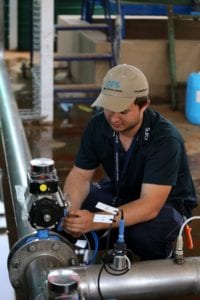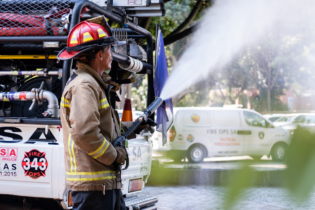Process efficiencies depend on precise technologies that require real-time monitoring and scheduled maintenance.
For applications like desalination and wastewater reuse, maintenance and continuous plant condition monitoring are of utmost importance to ensure that all risks are properly managed. Major risks of a poorly operated and maintained membrane plant include:- producing water unfit for human consumption
- the risk of breakdown
- inability to be online for water production
- unnecessary plant damage
- shorter membrane lifespans, resulting in
- higher operating costs.
Quality analysis
In association with continuous plant monitoring, regular samples need to be taken by an independent laboratory to verify and confirm operational conditions. This is required for both feedwater and product water to ensure that all indicators remain compliant, and to monitor changes in the feedwater. This may warrant changes to plant equipment or conditions to ensure that the plant can continue to treat the feedwater. A water treatment plant is designed for a specific feedwater and can accommodate limited changes in quality. A lack of feedwater quality monitoring may result in non-compliant final water or damage to plant equipment.In addition to continuous monitoring, regular preventative maintenance is of utmost importance. The instrumentation requires cleaning and calibration to ensure accurate measurements. Treatment technologies, such as ultrafiltration membranes and reverse osmosis membranes, also require periodic cleaning. Failure to do so will result in the malfunctioning of the membrane, rendering the plant ineffective in removing unwanted constituents.
Mechanical equipment, such as valves and pumps, must be inspected on a routine maintenance schedule. During pump maintenance early warning signs of worn bearings, worn seals or condensation damage to motors must be identified, so that replacement units can be arranged in advance. If a pump breaks down and spare parts are not readily available, the plant may be inoperative for an extended period, resulting in no water being produced. Advanced technologies, like membrane based plants, require a specialist operator for the continuous monitoring and maintenance schedules. Many times, new technologies get a ‘bad rap’ as a result of incorrect operation and maintenance by inexperienced staff. “QFS endeavours to impart as much knowledge to the operators during handover and training to ensure correct operation,” says Herman Smit, managing director, Quality Filtration Systems (QFS). “We’re also available to support clients in the operation and maintenance of the plants through a service level agreement, customised to their requirements. “As the applications for advanced technologies increase in a water-scarce country like South Africa, so should our skill level improve to correctly operate and maintain plants that will ensure our water security in the future,” he concludes.







